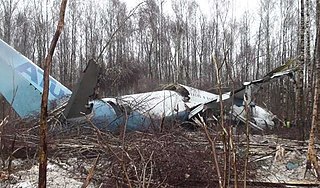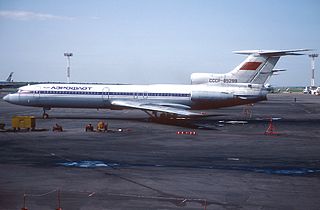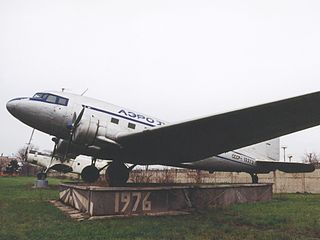
The Tupolev Tu-114 Rossiya is a retired large turboprop-powered long-range airliner designed by the Tupolev design bureau and built in the Soviet Union from May 1955. The aircraft was the largest and fastest passenger plane at that time and also had the longest range, at 10,900 km (6,800 mi). It has held the official title of fastest propeller-driven aircraft since 1960.

The Tupolev Tu-104 is a retired medium-range, narrow-body, twin turbojet-powered Soviet airliner. It was the second to enter regular service, behind the British de Havilland Comet and was the only jetliner operating in the world from 1956 to 1958, when the British jetliner was grounded due to safety concerns.

The Tupolev Tu-154 is a three-engined, medium-range, narrow-body airliner designed in the mid-1960s and manufactured by Tupolev. A workhorse of Soviet and (subsequently) Russian airlines for several decades, it carried half of all passengers flown by Aeroflot and its subsidiaries, remaining the standard domestic-route airliner of Russia and former Soviet states until the mid-2000s. It was exported to 17 non-Russian airlines and used as a head-of-state transport by the air forces of several countries.

The Tupolev Tu-124 is a 56-passenger short-range twinjet airliner built in the Soviet Union. It was the first Soviet airliner powered by turbofan engines.

Aeroflot Flight 411 was an international scheduled flight from Sheremetyevo Airport, Moscow to Freetown, Sierra Leone via Dakar in Senegal. Early on 6 July 1982, the four-engined Ilyushin Il-62 crashed and was destroyed by fire after two engines were shut down shortly after take-off. All 90 passengers and crew on board died as a result of the crash.

Aeroflot Flight 5143 was a domestic scheduled Karshi–Ufa–Leningrad passenger flight that crashed near Uchkuduk, Uzbek SSR, Soviet Union, on 10 July 1985. The crash killed all 200 occupants on board. Investigators determined that crew fatigue was a factor in the accident.

Aeroflot Flight 821 was a scheduled domestic passenger flight operated by Aeroflot-Nord in a service agreement with Aeroflot and as its subsidiary. On 14 September 2008, the aircraft operating the flight crashed on approach to Perm International Airport at 5:10 local time (UTC+06). All 82 passengers and six crew members were killed. Among the passengers who were killed was Russian Colonel General Gennady Troshev, an adviser to the President of Russia who had been the commander of the North Caucasus Military District during the Second Chechen War. A section of the Trans-Siberian Railway was damaged by the crash. Flight 821 is the deadliest accident involving a Boeing 737-500, surpassing the 1993 crash of Asiana Airlines Flight 733, and was the second-deadliest aviation incident in 2008, behind Spanair Flight 5022.

Aeroflot Flight 3352 was a regularly scheduled Aeroflot flight from Krasnodar to Novosibirsk, with an intermediate landing in Omsk. While landing at Omsk Airport on Thursday, 11 October 1984, the aircraft crashed into maintenance vehicles on the runway, killing 174 people on board and four on the ground. While a chain of mistakes in airport operations contributed to the accident, its major cause was an air traffic controller falling asleep on duty. As of 2022, this remains the deadliest aviation accident on Russian territory. It was also the deadliest aviation accident involving a Tupolev Tu-154 at the time until the crash of Aeroflot Flight 5143 nine months later; as of 2023, it still ranks as the second-deadliest accident involving a Tupolev Tu-154. The tragedy was kept secret for twenty years, until Komsomolskaya Pravda published an article in 2004.

On 11 August 1979, a mid-air collision occurred over the Ukrainian SSR, near the city of Dniprodzerzhynsk. The aircraft involved were both Tupolev Tu-134As on scheduled domestic passenger flights, operated by Aeroflot. All 178 people aboard both aircraft died in the accident. The Soviet aviation board investigating the accident concluded that the crash was caused by "mistakes and violations" made by air traffic controllers.

Aviastar-TU Flight 1906 was a Tupolev Tu-204 that crashed while attempting to land at Domodedovo International Airport, Moscow, Russia, in heavy fog on 22 March 2010. The aircraft was on a ferry flight from Hurghada International Airport, Egypt to Moscow, and had no passengers on board; all eight crew survived the accident, four with serious injuries requiring hospitalization and four with minor injuries. The accident was the first hull loss of a Tu-204 and the first hull loss for Aviastar-TU.

Alrosa Flight 514 was a Tupolev Tu-154 passenger jet on a domestic scheduled flight from Udachny to Moscow, Russia, that on 7 September 2010 made a successful emergency landing at a remote airstrip after suffering an in-flight total electrical failure. All 81 people on board escaped unharmed.

Aeroflot Flight 4225 was a Tupolev Tu-154B-2 on a scheduled domestic passenger flight from Alma-Ata Airport to Simferopol Airport on 8 July 1980. The aircraft had reached an altitude of no more than 500 feet when the airspeed suddenly dropped because of thermal currents it encountered during the climb out. This caused the airplane to stall less than 5 kilometres from the airport, crash and catch fire, killing all 156 passengers and 10 crew on board. To date, it remains the deadliest aviation accident in Kazakhstan.

Aeroflot Flight 141 was an international flight from Moscow to Prague. On 19 February 1973, the Tupolev Tu-154 crashed 1.5 kilometres short of runway 25 of Prague Ruzyně Airport. Most of the passengers survived the crash, but many died in the fire that followed. Out of the 87 passengers and 13 crew members, 62 passengers and 4 crew members perished with 18 occupants having serious injuries and the remaining 16 with either minor or no injuries. The crash was the first loss of and first fatal accident involving the Tu-154.

Aeroflot Flight 217 was a non-scheduled international passenger flight from Orly Airport in Paris to Sheremetyevo International Airport in Moscow, with a stopover at Shosseynaya Airport in Leningrad. On 13 October 1972, the Ilyushin Il-62 airliner operating the flight crashed on approach to Sheremetyevo, with the loss of all 164 passengers and crew of 10. At the time, it was the world's deadliest civil aviation disaster, until it was surpassed by the Kano air disaster in 1973. As of 2023, this remains the second-deadliest accident involving an Il-62, after LOT Flight 5055, and the second-deadliest on Russian soil, after Aeroflot Flight 3352.

Aeroflot Flight 3932 was a flight operated by Aeroflot from Koltsovo Airport to Omsk Tsentralny Airport. On 30 September 1973, the Tupolev Tu-104 operating the route crashed shortly after takeoff from Sverdlovsk, killing all 108 passengers and crew on board.

Aeroflot Flight 3519 was a Tupolev Tu-154B-2 airline flight on a domestic route from Krasnoyarsk to Irkutsk on 23 December 1984. Shortly after takeoff, the No. 3 engine caught fire, and the airplane crashed during an emergency landing. This killed 110 people; there was only one survivor, and the aircraft was destroyed. The engine fire was caused by a manufacturing defect in the compressor disk.

Aeroflot Flight 04 was a scheduled domestic passenger flight from Khabarovsk to Moscow with a stopover in Irkutsk that crashed on 15 August 1958, killing all 64 passengers and crew aboard the aircraft. It was the first fatal accident involving a Tupolev Tu-104.

Aeroflot Flight 068 was a regularly scheduled passenger flight operated by Aeroflot from Khabarovsk Novy Airport in Khabarovsk Krai to Pulkovo Airport in Saint Petersburg with intermediate stops at Tolmachevo Airport in Ob, Russia, then Koltsovo Airport in Yekaterinburg. On 16 March 1961, the Tupolev Tu-104B operating this flight crashed shortly after take off from Koltsovo Airport due to engine failure. Two crewmembers and 3 passengers along with two people on the ground, perished.

On 7 March 1965, an Aeroflot Li-2 operating as Aeroflot Flight 542 crashed shortly after takeoff from Abakan. Approximately 40 minutes after departure, the aircraft banked left and dived into the mountains of the Krasnoyarsk Krai region of the USSR. All 31 passengers and crew died, making it the deadliest known accident involving the Li-2.



















